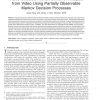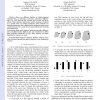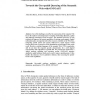521 search results - page 10 / 105 » Learning By Observation Using Qualitative Spatial Relations |
PAMI
2007
13 years 7 months ago
2007
—This paper presents a method for learning decision theoretic models of human behaviors from video data. Our system learns relationships between the movements of a person, the co...
ITNG
2010
IEEE
14 years 21 days ago
2010
IEEE
—There are different families of Spatio-temporal relations such as same-place same-time, same-place differenttimes, for road networks like overtake, derive beside and many others...
W2GIS
2007
Springer
14 years 1 months ago
2007
Springer
One of the challenges raised by the construction of the semantic Web lies in the analysis and management of complex relationships (thematic, spatial and temporal) connecting severa...
COSIT
2003
Springer
14 years 25 days ago
2003
Springer
The scope of this paper is a qualitative description of terrain features that can be characterized using the silhouette of a terrain. The silhouette is a profile of a landform seen...
ILP
2005
Springer
14 years 1 months ago
2005
Springer
Clustering is a fundamental task in Spatial Data Mining where data consists of observations for a site (e.g. areal units) descriptive of one or more (spatial) primary units, possib...



